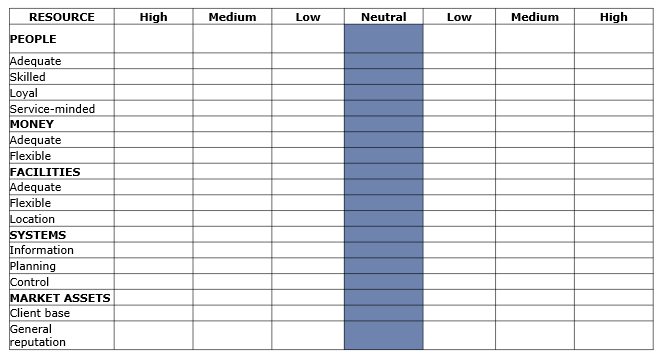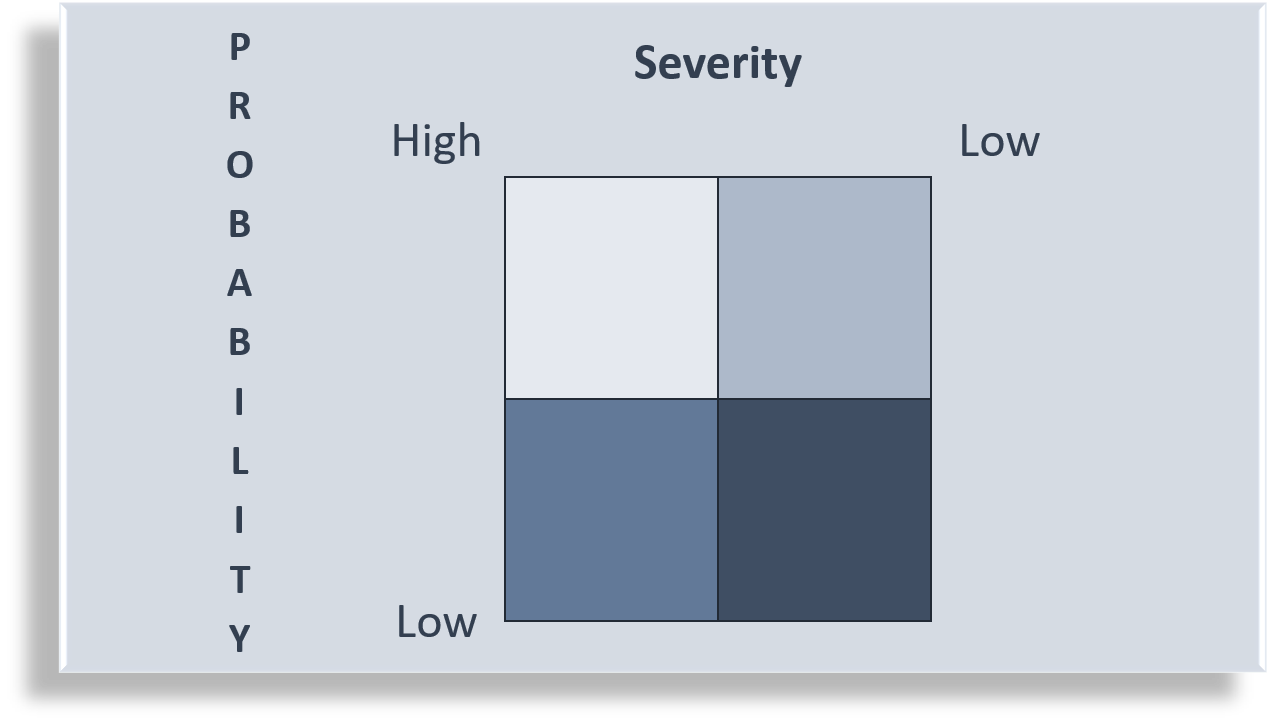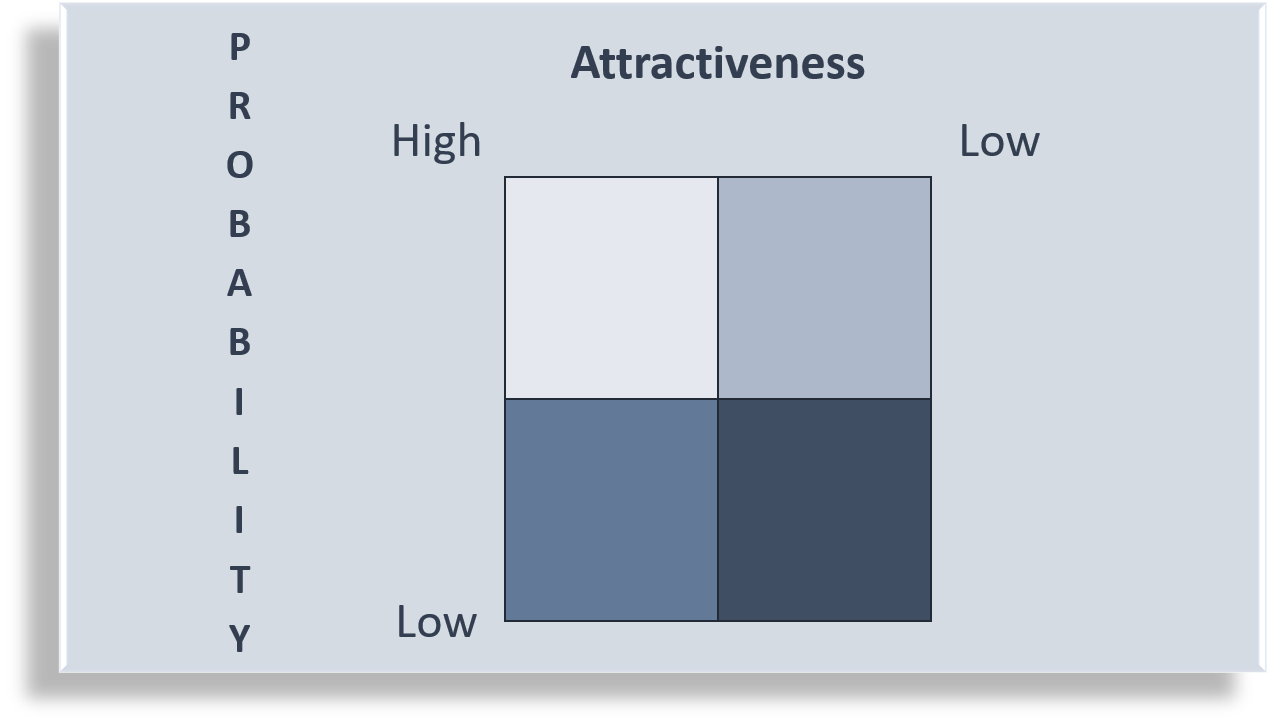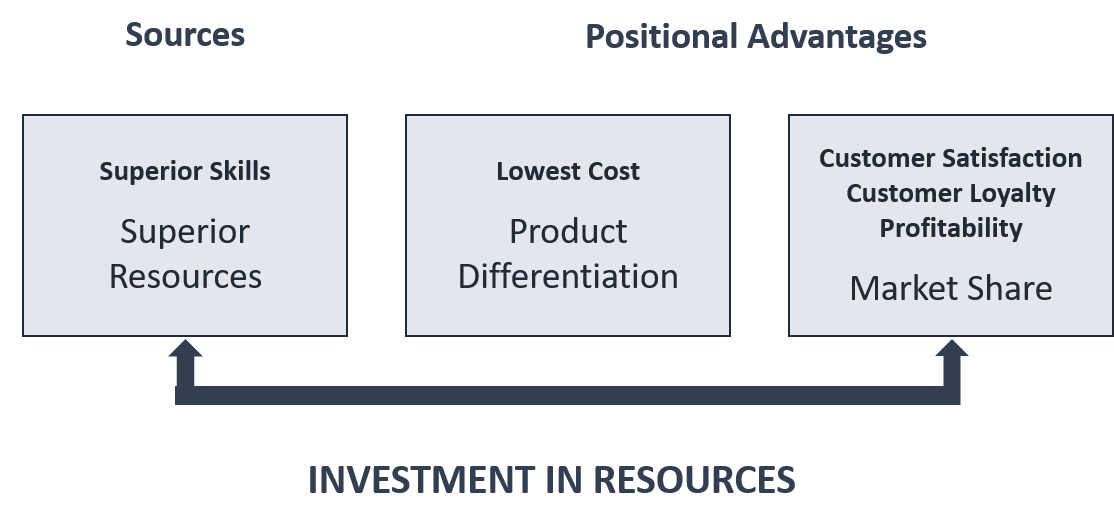The analysis of the current marketing situation provides the basis of data for a SWOT analysis.
Resource Analysis (Analysis of Strengths and Weaknesses)
Strengths and weaknesses are internal factors that the manager should identify. Strengths may be capitalised on, while weaknesses point to areas which the plan should correct the resource audit below allows one to do this.
Company Resource Analysis
Assess each of the following aspects of the organisation’s resources. Do you believe it represents a strength to the company (i.e. the company is in a better position than its competitors do) or a weakness (i.e. the company is in a worse position than its competitors do)?
The resource audit form on the next page is an extremely useful tool for a group of planners to use in assessing an organisation’s strengths and weaknesses. Obviously, the one shown in the example would not be suitable for all organisations.
It has been found that a planning team of between five and twelve managers can be used to complete a resource audit form. Each resource (and its critical dimensions) is rated according to whether the individual considers it to be a strength (low, medium, or high), a weakness (low, medium or high) or a neutral point (neither a strength nor a weakness). When each member in the group has completed the individual ratings, an aggregate is found, and the results made available to the planning team during a discussion session. What happens is that there is a wide range of views and different members of the planning team can ten give and gain insight into the various organizational resources. Individuals must complete an audit form and the process is repeated. The insights gained during the discussions and re-evaluation of the resource profile eventually leads to conformity and congruence, as individuals begin to see an overall picture from each other’s point of view. The resulting resource profile can be drawn as a plot along the means on the resource audit form, providing a snapshot of the resource situation in the organisation.
TICA-Treat’s Strengths
Bill Jones has identified the following as Tica-treat’s strengths:
- A high-level of brand awareness
- Good relations with buyers (the mines)
The following as weaknesses:
- Low advertising expenditure means that brand awareness has not resulted in brand loyalty (the buyer is willing to switch brands with minimal persuasion).
- Poor packaging in comparison to competitors (outdated package design).
- No defined positioning for the brand.

Environmental Analysis
Opportunities and threats refer to outside factors that can affect the future of business and over which it has not control. Opportunities are observed trends or possible trends in the environment which are attractive to the firm. Threats are observed or possible trends in the environment that could be detrimental to the firm. Failure to identify opportunities and threats can lead to stagnation.
Many organisations can identify threats in the environment but then ignore them. The threat matrix offers a simple but powerful way of classifying and managing threats. To use it, the planning team simply needs to consider each of the threats identified and place them on the grid in the appropriate cell, evaluating each threat, in term of its severity and probability of occurrence.
A serious threat is one that, if it materialized, could seriously hurt the company. If in addition it were highly likely to occur, it would be placed in the upper left quadrant. It would have to be managed constantly and contingency plans would be developed. A threat with low likelihood or not a serious threat, placed in the bottom right cell, could even be ignored. Threats in the other two quadrants could be monitored in terms of their movement along the axes.
Just as a planning team needs to consider the threats facing it, so too it must develop some facility of identifying, classifying and managing opportunities. An opportunity matrix can be used in very much the same way as a threat matrix. Attractive, probable opportunities should be managed and exploited; less attractive, less likely ones ignored; and opportunities in the bottom left to top right diagonal monitored for shifts in position. An opportunity matrix is illustrated opposite.
Bill Jones has identified the following opportunities facing Tica-treat:
Mines using local products, as they are cheaper than imported products, due to the weakness of the currency.


Threat Matrix
A threat matrix:
- Changes in environmental legal requirements should increase the use of products such as Tica-treat and the following as threats.
- Possible loss of the Japanese Tica suppliers as a result of poor relations with Smith’s.
- Major scientific advances by two American competitors.
Analysis of The Competitive Situation
Any appraisal of the strategic and marketing situation must include an analysis of the competitive situation. Too often, unfortunately, managers and academics alike misuse the term’ competitive advantage’. The cliché has been used and abused to the extent that its true meaning has become unclear. An excellent, simple model for understanding exactly what competitive advantage is and where it comes from is illustrated below.

Organisations have only two sources of competitive advantage. They either have superior skills (knowledge; ability; expertise) or they have superior resources (more money, more and better people, better plans, better facilities, better location, better information technology). Really-fortunate organisations have both. These sources of competitive advantage are used to gain a position of advantage. This positional advantage can either be the ability to be the lowest cost producer or the ability to offer superior customer value. The ability to be the lowest cost producer means that the organisation can command a pricing advantage (sell at a lower price than competitors while making similar or higher price margins).
Alternatively, the company can sell at the same price as competitors and command higher margins. If the organisation cannot command a position of lower cost, it must compete based on offering superior customer value. It must differentiate its product to the market in such a way that customers demand that product and may even pay more for it. This differentiation may take the form of better quality, more features, better service, longer warranty, bigger range, added convenience – whatever it is, it is something that makes the company’s product different from that of its competitors.
If the organisation does command a positional advantage, several things will result, all of which should be important to management. The company will have customers who are so satisfied that they will support the company loyally. In addition, the company will be profitable, and will maintain and even increase its share in the market. Theoretically, the financial results of competitive advantage are then ploughed back into what created the competitive advantage in the first place: superior skills and/or superior resources.
Most organisations give more attention to outcomes such as market share and profitability, than satisfaction and loyalty. The reason appears flawed when one considers that profitability and market share are transitory measures, taken at a point in time. Financial statements, for example, are really a company’s history and say little of its strategic future. Measures of satisfaction and loyalty are undoubtedly more effective indicators of strategic health.